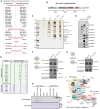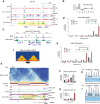Recurrent chromosomal translocations in sarcomas create a megacomplex that mislocalizes NuA4/TIP60 to Polycomb target loci
- PMID: 35710139
- PMCID: PMC9296003
- DOI: 10.1101/gad.348982.121
Recurrent chromosomal translocations in sarcomas create a megacomplex that mislocalizes NuA4/TIP60 to Polycomb target loci
Abstract
Chromosomal translocations frequently promote carcinogenesis by producing gain-of-function fusion proteins. Recent studies have identified highly recurrent chromosomal translocations in patients with endometrial stromal sarcomas (ESSs) and ossifying fibromyxoid tumors (OFMTs), leading to an in-frame fusion of PHF1 (PCL1) to six different subunits of the NuA4/TIP60 complex. While NuA4/TIP60 is a coactivator that acetylates chromatin and loads the H2A.Z histone variant, PHF1 is part of the Polycomb repressive complex 2 (PRC2) linked to transcriptional repression of key developmental genes through methylation of histone H3 on lysine 27. In this study, we characterize the fusion protein produced by the EPC1-PHF1 translocation. The chimeric protein assembles a megacomplex harboring both NuA4/TIP60 and PRC2 activities and leads to mislocalization of chromatin marks in the genome, in particular over an entire topologically associating domain including part of the HOXD cluster. This is linked to aberrant gene expression-most notably increased expression of PRC2 target genes. Furthermore, we show that JAZF1-implicated with a PRC2 component in the most frequent translocation in ESSs, JAZF1-SUZ12-is a potent transcription activator that physically associates with NuA4/TIP60, its fusion creating outcomes similar to those of EPC1-PHF1 Importantly, the specific increased expression of PRC2 targets/HOX genes was also confirmed with ESS patient samples. Altogether, these results indicate that most chromosomal translocations linked to these sarcomas use the same molecular oncogenic mechanism through a physical merge of NuA4/TIP60 and PRC2 complexes, leading to mislocalization of histone marks and aberrant Polycomb target gene expression.
Keywords: EPC1; H3K27 methylation; H4 acetylation; HOXD; JAZF1; NuA4; PHF1; PRC2; SUZ12; TIP60.
© 2022 Sudarshan et al.; Published by Cold Spring Harbor Laboratory Press.
Figures






Similar articles
-
The JAZF1-SUZ12 fusion protein disrupts PRC2 complexes and impairs chromatin repression during human endometrial stromal tumorogenesis.Oncotarget. 2017 Jan 17;8(3):4062-4078. doi: 10.18632/oncotarget.13270. Oncotarget. 2017. PMID: 27845897 Free PMC article.
-
JAZF1-SUZ12 dysregulates PRC2 function and gene expression during cell differentiation.Cell Rep. 2022 May 31;39(9):110889. doi: 10.1016/j.celrep.2022.110889. Cell Rep. 2022. PMID: 35649353 Free PMC article.
-
Frequency of known gene rearrangements in endometrial stromal tumors.Am J Surg Pathol. 2011 Sep;35(9):1364-72. doi: 10.1097/PAS.0b013e3182262743. Am J Surg Pathol. 2011. PMID: 21836477
-
A novel MBTD1-PHF1 gene fusion in endometrial stromal sarcoma: A case report and literature review.Genes Chromosomes Cancer. 2020 Jul;59(7):428-432. doi: 10.1002/gcc.22845. Epub 2020 Apr 15. Genes Chromosomes Cancer. 2020. PMID: 32237188 Review.
-
JAZF1/SUZ12 gene fusion in endometrial stromal sarcomas.Orphanet J Rare Dis. 2016 Feb 16;11:15. doi: 10.1186/s13023-016-0400-8. Orphanet J Rare Dis. 2016. PMID: 26879382 Free PMC article. Review.
Cited by
-
TAZ/YAP fusion proteins: mechanistic insights and therapeutic opportunities.Trends Cancer. 2022 Dec;8(12):1033-1045. doi: 10.1016/j.trecan.2022.08.002. Epub 2022 Sep 9. Trends Cancer. 2022. PMID: 36096997 Free PMC article. Review.
-
Understanding the role of BRD8 in human carcinogenesis.Cancer Sci. 2024 Sep;115(9):2862-2870. doi: 10.1111/cas.16263. Epub 2024 Jul 5. Cancer Sci. 2024. PMID: 38965933 Free PMC article. Review.
-
Know when to fold 'em: Polycomb complexes in oncogenic 3D genome regulation.Front Cell Dev Biol. 2022 Aug 29;10:986319. doi: 10.3389/fcell.2022.986319. eCollection 2022. Front Cell Dev Biol. 2022. PMID: 36105358 Free PMC article. Review.
-
Functional Classification of Fusion Proteins in Sarcoma.Cancers (Basel). 2024 Mar 29;16(7):1355. doi: 10.3390/cancers16071355. Cancers (Basel). 2024. PMID: 38611033 Free PMC article. Review.
-
Structural insights into the human NuA4/TIP60 acetyltransferase and chromatin remodeling complex.Science. 2024 Aug 23;385(6711):eadl5816. doi: 10.1126/science.adl5816. Epub 2024 Aug 23. Science. 2024. PMID: 39088653 Free PMC article.
References
-
- Andrews S. 2010. FastQC: a quality control tool for high throughput sequence data.
-
- Antonescu CR, Sung YS, Chen CL, Zhang L, Chen HW, Singer S, Agaram NP, Sboner A, Fletcher CD. 2014. Novel ZC3H7B-BCOR, MEAF6-PHF1, and EPC1-PHF1 fusions in ossifying fibromyxoid tumors—molecular characterization shows genetic overlap with endometrial stromal sarcoma. Genes Chromosomes Cancer 53: 183–193. 10.1002/gcc.22132 - DOI - PMC - PubMed
Publication types
MeSH terms
Substances
Grants and funding
LinkOut - more resources
Full Text Sources
Medical
Miscellaneous
